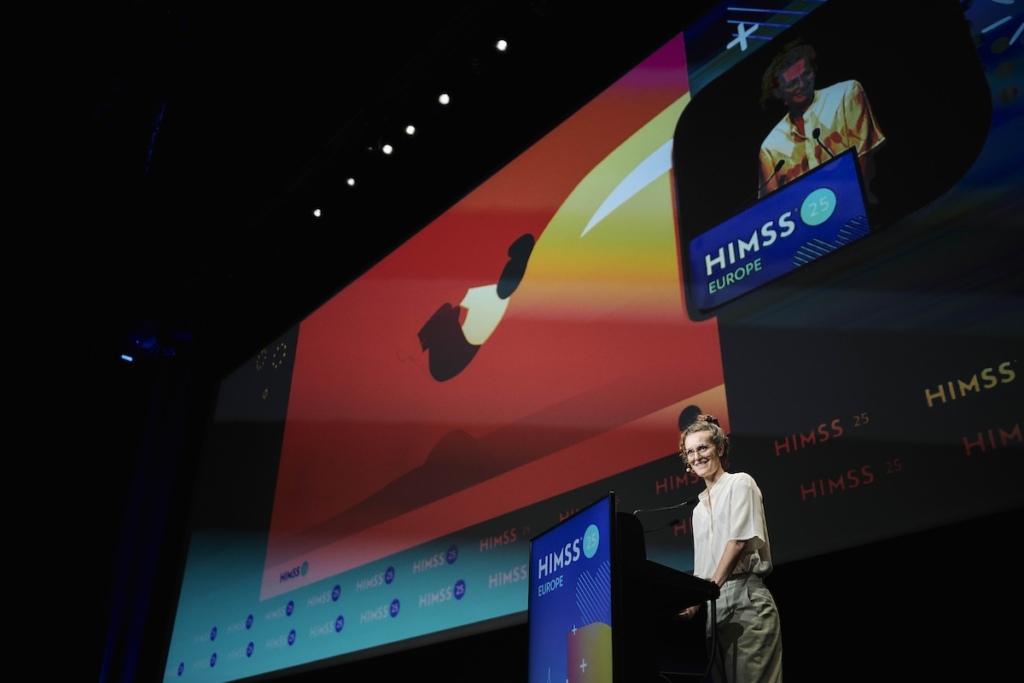
When Ida Tin experienced a level four tear during childbirth – the most severe kind possible – she later learned about a product that could have prevented it. The sticker-like device from oasi care reduces tearing risk, but it still wasn’t available to patients. When her recent pap smear showed HPV, her doctor told her to wait and see. Instead, Tin found research suggesting four supplements could help clear the virus, but no one was tracking her data or guiding her treatment.
These personal experiences illustrate a larger point that Tin, founder of the period-tracking app Clue and the person who coined the term “femtech,” made during her keynote at HIMSS Europe in Paris earlier this month: women’s health isn’t just a market opportunity – it’s critical societal infrastructure that we’ve failed to maintain.
Infrastructure We Can’t See
“We have grids for electricity, we have pipelines for gas, but our bodies, together with our healthcare systems and our medicines, that is the infrastructure that allows women’s energy to flow into society,” Tin explains.
This infrastructure metaphor reframes how we think about women’s health technology. Just as we wouldn’t expect society to function without reliable electricity or water systems, Tin argues we can’t expect women to participate fully in society without proper health infrastructure.
The problem is that much of women’s health happens in the invisible realm – the complex hormonal cycles, reproductive challenges, and physical experiences that our culture has historically avoided discussing. “What it feels like to have a female body is so often invisible,” Tin notes.
The Wild Ride of Female Biology
Tin describes the female reproductive journey as “a really wild ride” – periods, pregnancy attempts, pregnancy loss, birth complications, hormonal issues, fibroids, cysts, breastfeeding challenges, sexual health problems, and eventually menopause. “We have our uteruses and breasts removed, and the list goes on.”
Each of these experiences represents a potential point of system failure if the supporting infrastructure isn’t adequate. When it takes an average of seven years to diagnose endometriosis – a condition affecting 10-15% of women – that represents infrastructure breakdown affecting millions.
Tin’s own perimenopause experience highlights these gaps. She wanted to monitor her hormones in real time to understand whether bleeding for a month was normal hormonal fluctuation or something requiring medical attention. When she consulted her gynecologist about her copper IUD, she was told to remove it. A colleague said to leave it in. “I guess I’ll just maybe see what happens,” Tin recalls. “That’s a data gap.”
Technology Filling the Gaps
Tin founded Clue after struggling with hormonal birth control and wanting a simple answer: “Can I get pregnant today? Yes or no.” That app now has over 10 million users and became the world’s first FDA-cleared, 100% data-driven contraceptive method back in 2021.
But Clue was just the beginning. In 2016, Tin coined the term “femtech” at a major tech conference, recognizing that a handful of companies were starting to build solutions for women’s health needs. “I wanted this to be understood as a huge new thing happening in tech,” she explains.
The timing was crucial. As cultural conversations around women’s health expanded – The New York Times called 2015 “the year the period went public” – technology followed. Period underwear, tampons with CBD oil, and even tampons as diagnostic tools emerged as periods became speakable.
The Infrastructure Investment Case
Femtech is now expected to become a $1.1 trillion industry by 2040, but Tin argues this isn’t about market size – it’s about infrastructure necessity. McKinsey reported that inadequate women’s healthcare costs the world $1 trillion annually.
“There’s a lot of money to be made and there’s a lot of money to be saved when we invest in women’s health,” Tin says.
Yet funding remains inadequate. When investors say they haven’t seen big exits yet, she responds, “We haven’t seen the big growth rounds yet. It’s like a chicken-egg situation.”
Tin pushes back against the perception that femtech is niche. “Addressing needs for half of the world’s population is not niche – it is societal infrastructure.”
Building the Right Infrastructure
Critical to Tin’s argument is who builds this infrastructure. “If femtech is built without women’s participation, we run a high risk of the products ending up feeling off,” she warns. This concern extends to AI systems that will replicate gender bias if training data isn’t corrected.
“We need men to participate, but we need them to do it together with us,” Tin says. “We must build this new digital world to fit women’s bodies.”
Today, femtech development spans globally, supported by venture capital funds, accelerators, and university programs. “This is a global movement, and it is unstoppable,” Tin declares. “It is fueled by real needs, real business opportunity, and also by real anger.”
For Tin, the path forward is clear: “Ask women what they need. Ask what is still too painful, and you will come up with an incredibly inspiring list of business opportunities.”
The infrastructure metaphor reframes these opportunities not as nice-to-haves, but as essential systems that enable half the world’s population to participate fully in society.



